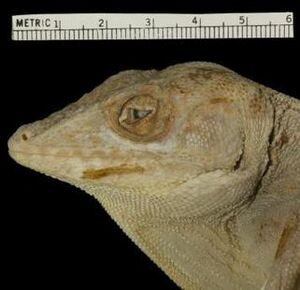Culebra Island giant anole facts for kids
Quick facts for kids Culebra Island giant anole |
|
|---|---|
 |
|
| Conservation status | |
| Scientific classification | |
| Synonyms | |
|
The Culebra Island giant anole (scientific name: Anolis roosevelti) is a very rare lizard that might even be extinct. It's also known as the Virgin Islands giant anole or Roosevelt's giant anole. This special lizard belongs to the Anolis group of lizards. It is native to the Virgin Islands and Vieques.
Contents
About the Culebra Giant Anole
How it Got its Name
The Culebra Island giant anole was first described in 1931. An American zoologist named Chapman Grant discovered it. He was the grandson of Ulysses S. Grant, a former U.S. President.
The lizard was named after Theodore Roosevelt Jr.. He was the governor of Puerto Rico when the lizard was discovered. Scientists first called it Anolis roosevelti.
Where it Lives
The Anolis roosevelti lives only on Culebra Island in Puerto Rico. It also lives in the Virgin Islands. This means it is endemic to these islands.
Its Home in the Forest
This anole lives in forests. It prefers the slopes of a place called Mt. Resaca. It likes areas with gumbo-limbo and ficus trees. This is because it eats the fruits from these trees.
What it Looks Like
The Culebra giant anole can grow quite large. It can be about 160 mm (about 6.3 inches) long from its snout to the base of its tail.
Its body is brownish-gray. Its tail has a yellowish-brown color. The belly area is whitish. The throat fan, which is a flap of skin under its chin, is gray on top and yellow underneath. Its eyelids are also yellow. This lizard also has two long lines on each side of its body. One line starts near its ear, and the other begins at its shoulder.
How it Reproduces
The Anolis roosevelti is an oviparous animal. This means that the female lays eggs.
Why This Anole is Rare
The Culebra Island giant anole was only seen again in 1932 after it was first discovered. There have been a few unconfirmed sightings since 1973, with the last one in 1978. Some experts still believe it might be alive today.
The main reason this anole is so rare is because its home has been destroyed. People have changed the forests where it lived. Because of this, there are only a few specimens of the Culebra Giant Anole left in museums. In 1977, it was officially listed as a federally endangered species.
See also


